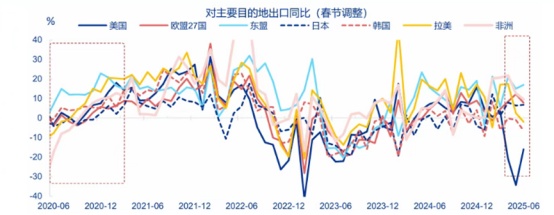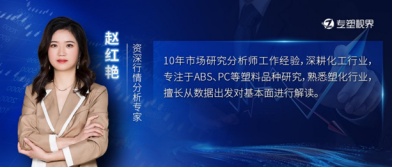Export resilience amid tariff games: Insights from June Foreign Trade Data on the Home Appliance Industry and Plastic Demand
In June, China's exports grew by 5.8% year-on-year, an increase of 1 percentage point from May, with the month-on-month growth rate approaching the median of the past five years, demonstrating unexpected resilience. The home appliance industry has become a beneficiary of this round of export recovery. The primary reasons for this rebound are the alleviation of tariff pressures resulting from the easing of China-U.S. trade tensions, coupled with structural opportunities arising from adjustments in the global trade landscape.
Tariff Delay and Export Recovery: A Game of Time for Space
The core driver of the rebound in export growth in June comes from a significant improvement in exports to the United States (as shown in the chart below). The effects of the mutual tariff reductions between China and the U.S. in mid-May became evident in June, leading to a narrowing of the export decline to the U.S. by 18.4 percentage points to -16.1%. This improvement has a clear characteristic of policy lag—typically, it takes 2-3 weeks from tariff adjustments to shipping out from ports, which means the easing of policies in late May is fully reflected in the June data.

It is worth noting that the tariff strategy of the Trump administration exhibits a clear "tiered" characteristic: maintaining a moderate tax rate of 10-20% on large economies, while implementing a high-pressure policy of "20% direct imports + 40% transshipments" on smaller economies with active transshipment trade, such as Vietnam. This differentiated strategy has objectively created a comparative advantage for products like Chinese household appliances. Data shows that from January to June, cumulative exports of household appliances reached 2.21 billion units, a year-on-year increase of 3.5%, with exports to the European Union experiencing rapid growth.
The tariff dividends in the home appliance industry: structural beneficiaries emerge.
Against the backdrop of an overall recovery in exports, the home appliance industry has performed particularly well. The reasons for this can be analyzed from three dimensions:
Firstly, the relative advantages under the tariff gradient. Against the backdrop of the average import tariff in the United States rising to 28.9%, China may only face a basic tariff of 10%, which is significantly more advantageous compared to transshipment countries like Vietnam. This has led to a noticeable improvement in direct trade channels for mature manufacturing industries, such as home appliances, with a significant month-on-month increase in exports of home appliances to the U.S. in June.
Secondly, the alternative growth of the EU market. In the first half of the year, China's imports and exports to the EU grew by 3.5%, with outstanding performance in home appliance exports. The share of home appliances imported from China in the EU has exceeded 60% of similar products, reflecting the irreplaceability of China's supply chain.
Thirdly, the drive for product structure upgrades. Categories with higher added value, such as smart home appliances and energy-saving products, have seen faster export growth, partially offsetting the price pressure on traditional products. Customs data shows that the export unit price of products with Internet of Things (IoT) functions, such as air conditioners and refrigerators, has increased by 8-12% year-on-year.
From Home Appliance Exports to Plastic Demand: Weak Recovery Under Lagged Transmission
The export performance of the home appliance industry indirectly reflects the strength of demand for upstream plastics. On average, the cost of plastics accounts for about 15-25% of home appliance products, with large appliances like refrigerators and washing machines using 5-8 kilograms of plastics per unit.
Looking ahead, the demand for plastics may exhibit three phased characteristics:
In the short term, there is still residual heat in export demand. Data from the first 13 days of July shows a decrease in the number of container ships, but home appliance companies are still accelerating their shipment pace to avoid potential tariff adjustments in August, which provides short-term support for the demand for engineering plastics, ABS, and other materials.
In the medium term, the overdraft effect is becoming apparent. As the momentum for "grabbing exports" diminishes and the U.S. inventory cycle enters a phase of reduction, the export growth of home appliances may decline, which will weaken the demand for plastics. In particular, general-purpose plastics such as PP and HDPE used for outer packaging may be the first to be affected.
Risks and Variables: The Nonlinear Impact of Tariff Policies
It is necessary to be vigilant about the uncertainties in the U.S. tariff policy towards China in early August. If the final tax rate exceeds the expected 10%, or if re-export regulatory policies tighten more than anticipated, it may cause a secondary shock to home appliance exports. In addition, the European Union's Carbon Border Adjustment Mechanism (CBAM) has already included plastic products in its pilot phase, which may increase compliance costs for home appliance companies in the medium to long term.
Author: Zhao Hongyan, Expert in Market Research at Zhuansu Shijie

【Copyright and Disclaimer】This article is the property of PlastMatch. For business cooperation, media interviews, article reprints, or suggestions, please call the PlastMatch customer service hotline at +86-18030158354 or via email at service@zhuansushijie.com. The information and data provided by PlastMatch are for reference only and do not constitute direct advice for client decision-making. Any decisions made by clients based on such information and data, and all resulting direct or indirect losses and legal consequences, shall be borne by the clients themselves and are unrelated to PlastMatch. Unauthorized reprinting is strictly prohibited.
Most Popular
-

At Least 44 Dead in Century-Old Fire! Questioning Hong Kong's Hong Fu Garden: Why Has the Path to Fire Resistance Taken 15 Years Without Progress?
-

Satellite chemical's profits surge! can the 26.6 billion yuan high-end new materials project meet expectations? a review of progress on four major projects
-

Key Players: The 10 Most Critical Publicly Listed Companies in Solid-State Battery Raw Materials
-

Estun Turns Profitable in 2025 Half-Year Report, Industrial Robot Shipments Rank First Among Domestic Brands
-

Avatr Files for IPO on HKEX, Plans to Complete Listing in Q2 2026






